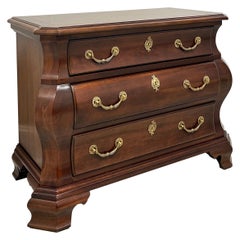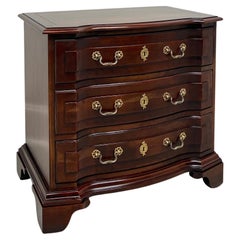Century Cardella Commode
Recent Sales
Late 20th Century American Other Commodes and Chests of Drawers
Brass
Late 20th Century American Other Commodes and Chests of Drawers
Brass
Century Furniture for sale on 1stDibs
Known for its durable vintage display cabinets, nightstands and dressers made of cherry, oak, walnut and more, Century Furniture of Hickory, North Carolina, began as an upholstered goods company in 1947 but added case goods and sophisticated mahogany dining-room furnishings shortly thereafter.
Launched by Harley Ferguson Shuford Sr., a Hickory native who was born to a family of textile mill owners, Century Furniture was intended to be “the best furniture company in the world.” With respect to speed and efficiency, the brand found its footing midway through production on a government contract that Shuford had secured in the early days to manufacture thousands of five-drawer chests. The effort was significant, but it was also a teachable moment as far as Shuford and his team’s learning the ropes of running a factory.
After hiring designer Raymond K. Sobota in 1950 and introducing the enormously popular Citation Collection in 1954, Century established its reputation as a leader in stylishly designed high-quality furniture. Sobota had furniture in his blood — after graduating from Kendall College of Art & Design in Grand Rapids, Michigan, he worked for his uncle Karl Schmidt, who was at the time a well-known furniture designer for Berkey and Gay and other makers in the Grand Rapids area, then known as America’s furniture capital. Sobota soon launched his own studio, designing furniture as a freelancer for various local manufacturers. Shuford found him by happenstance, journeying to Michigan’s second-largest city to offer a job to another designer who turned him down but recommended Sobota instead.
Century’s Citation line — a sizable collection for the brand that spanned furnishings for the bedroom, dining room and more — is revered in the world of vintage mid-century modern furniture collectors. The pieces sold very well during the 1950s, and the line is an oft-cited success story for Sobota, who would go on to win awards for his work and whose own catalogue of designs for the brand is massive.
In his 40-year career at Century, until he retired in 1995, he designed well over 100 furniture lines. Sobota’s nightstands, cabinets, side tables and more are characterized by his interest in Asian design, distinctly and brilliantly expressed in his Hollywood Regency–style Chin Hua line, which debuted during the 1970s. With its geometrically decorative brass drawer pulls and door handles as well as dining-chair seat-back carvings — all inspired by Asian motifs — this collection has rendered vintage pieces that saw Century’s craftsmen working with alluring ebonized walnut and more, some of the company’s most sought-after work today.
Also in the 1970s as well as in the 1980s, Manhattan interior designer Jay Spectre introduced an Art Deco–informed spirit at Century Furniture, creating oversize, inviting lounge chairs and bentwood benches that featured plush tufted leather cushions. Spectre’s Eclipse collection was at one point among the largest-selling lines for the brand.
Century licensed collections with celebrity interior designers such as Thomas O’Brien, Charlotte Moss and Bunny Williams among others. In 2013, when Alex Shuford III was named president of Century Furniture, the move marked the succession of the third generation to lead this company, which is today one of the world’s largest privately held manufacturers of high-end furniture.
Find Century Furniture lounge chairs and dining chairs as well as vintage mid-century modern credenzas, dressers and more on 1stDibs.
Materials: Brass Furniture
Whether burnished or lacquered, antique, new and vintage brass furniture can elevate a room.
From traditional spaces that use brass as an accent — by way of brass dining chairs or brass pendant lights — to contemporary rooms that embrace bold brass decor, there are many ways to incorporate the golden-hued metal.
“I find mixed metals to be a very updated approach, as opposed to the old days, when it was all shiny brass of dulled-out silver tones,” says interior designer Drew McGukin. “I especially love working with brass and blackened steel for added warmth and tonality. To me, aged brass is complementary across many design styles and can trend contemporary or traditional when pushed either way.”
He proves his point in a San Francisco entryway, where a Lindsey Adelman light fixture hangs above a limited-edition table and stools by Kelly Wearstler — also an enthusiast of juxtapositions — all providing bronze accents. The walls were hand-painted by artist Caroline Lizarraga and the ombré stair runner is by DMc.
West Coast designer Catherine Kwong chose a sleek brass and lacquered-parchment credenza by Scala Luxury to fit this San Francisco apartment. “The design of this sideboard is reminiscent of work by French modernist Jean Prouvé. The brass font imbues the space with warmth and the round ‘portholes’ provide an arresting geometric element.”
Find antique, new and vintage brass tables, case pieces and other furnishings now on 1stDibs.
Finding the Right Commodes-chests-of-drawers for You
Shopping for a commode or a chest of drawers?
Commode is the French term for a low chest of drawers, but it is also sometimes used to denote any case piece with a particularly intricate design. The commode dates to circa 1700 France, where it was used as an alternative to a taller cabinet piece so as to not obscure paneled, mirrored or tapestried walls. Coffers, or chests, which were large wooden boxes with hinged lids and sometimes stood on ball feet, preceded chests of drawers, a fashionable cabinet furnishing that garnered acclaim for its obvious storage potential and versatility. The term commode was also used to refer to a piece of bedroom furniture — a washstand or nightstand that contained a chamber pot.
As time passed, French and British furniture makers led the way in the production of chests of drawers, and features like the integration of bronze and ornamental pulls became commonplace. Antique French commodes in the Louis XV style were sometimes crafted in mahogany or walnut, while an Italian marble top added a sophisticated decorative flourish. This specific type of case piece grew in popularity in the years that followed.
So, what makes a chest of drawers different from a common dresser? Dressers are short, and chests of drawers are overall taller pieces of furniture that typically do not have room on the top for a mirror as most dressers do. Tallboys and highboys are variations of the dresser form. Some chests of drawers have one column of four to six long drawers or three long drawers in their bottom section that are topped by a cluster of small side-by-side drawers on the top. To further complicate things, we sometimes refer to particularly short chests of drawers as nightstands.
Even though chests of drawers are commonly thought of as bedroom furniture to store clothing, these are adaptable pieces. A chest of drawers can house important documents — think of your walnut Art Deco commode as an upgrade to your filing cabinet. Nestle your chest near your home’s front door to store coats and other outerwear, while the top can be a place to drop your handbag. Add some flair to your kitchen, where this lovable case piece can hold pots, pans and even cookbooks.
When shopping for the right chest of drawers for your home, there are a few key things to consider: What will you be storing in it? How big a chest will you need?
Speaking of size, don’t dream too big. If your space is on the smaller side, a more streamlined vintage mid-century modern chest of drawers, perhaps one designed by Paul McCobb or T.H. Robsjohn-Gibbings, may best suit your needs.
At 1stDibs, we make it easy to add style and storage to your home. Browse our collection of antique and vintage commodes and chests of drawers today.
- What is mid century furniture?1 Answer1stDibs ExpertFebruary 22, 2021Mid-century furniture is furniture created within the period of 1933 to 1965 but most would argue that the style began to emerge in the postwar years. This style of furniture is known for its sleek lines and organic shapes. The creators most frequently associated with mid-century modern furniture believed that good design meant good living. Mid-century modern is today by far the largest category of furnishings on 1stDibs.
- 1stDibs ExpertSeptember 25, 2019
Mid-century modern furniture combines sleek lines with organic shapes.
- 1stDibs ExpertSeptember 25, 2019
Some of the most famous mid-century modern furniture designers were Alvar Aalto, Charles and Ray Eames, Paul Evans, Poul Kjærholm, Florence Knoll, George Nakashima, Giò Ponti, Hans Wegner, Charlotte Perriand, Sergio Rodrigues and Eero Saarinen.
- 1stDibs ExpertMay 22, 2019
Mid-century modernism first appeared in 1945 and merged a minimalist aesthetic with practicality. Mid-century modern furniture is distinguishable by its lack of decoration or extravagance and its use of clean lines, organic curves and variety of natural materials.
1stDibs ExpertFebruary 22, 2021Mid century modern furniture refers to pieces designed during the middle of the 20th century — specifically 1930s through the mid-1960s. This period represents a design and architecture movement characterized by simple shapes, clean lines, and organic materials. Some of the most famous mid century modern designers include Ray Eames, Charlotte Perriand, Isamu Noguchi and Eero Saarinen.

